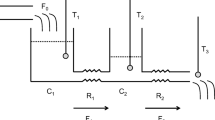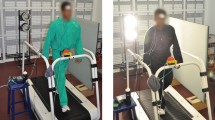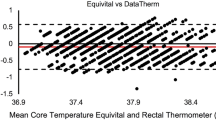Abstract
Fire suppression and rescue is a physiologically demanding occupation due to extreme external heat as well as the physical and thermal burden of the protective garments. These conditions challenge body temperature homeostasis and results in heat stress. Accurate field assessment of core temperature is complex and unreliable. The present investigation developed a perceptually based hyperthermia metric to measure physiologic exertional heat strain during treadmill exercise. Sixty-five (28.9 ± 6.8 years) female (n = 11) and male (n = 54) firefighters and non-firefighting volunteers participated in four related exertional heat stress investigations performing treadmill exercise in a heated room while wearing thermal protective clothing. Body core temperature, perceived exertion, and thermal sensation were assessed at baseline, 20-mins exercise, and at termination. Perceived exertion increased from baseline (0.24 ± 0.42) to termination (7.43 ± 1.86). Thermal sensation increased from baseline (1.78 ± 0.77) to termination (4.50 ± 0.68). Perceived exertion and thermal sensation were measured concurrently with body core temperature to develop a two-dimensional graphical representation of three exertional heat strain zones representative of a range of mean body core temperature responses such that low risk (green) incorporated 36.0–37.4°C, moderate risk (yellow) incorporated 37.5–37.9°C, and high risk (red) incorporated 38.0 to greater than 40.5°C. The perceptual hyperthermia index (PHI) may provide a quick and easy momentary assessment of the level of risk for exertional heat stress for firefighters engaged in fire suppression that may be beneficial in high-risk environments that threaten the lives of firefighters.

Similar content being viewed by others
References
Belding HS, Hatch TF (1955) Index for evaluating heat stress in terms of resulting physiological strain. Heat Pip Air Cond 27:129–136
Bilzon JL, Scarpello EG, Smith CV, Ravehill NA, Rayson MP (2001) Characterization of the metabolic demands of simulated shipboard royal navy fire-fighting tasks. Ergonomics 44:766–780
Casa DJ, Roberts WO (2003) Considerations for the medical staff: preventing, identifying, and treating exertional heat illnesses. In: Armstrong LE (ed) Exertional heat illnesses. Human Kinetics, Champaign, pp 177–181
Cheung SS, McLellan TM (1998) Influence of hydration status and fluid replacement on heat tolerance while wearing NBC protective clothing. Eur J Appl Physiol Occup Physiol 7:139–148
Cheung SS (2007). Neuropsychologial determinants of exercise tolerance in the heat. In: Sharma HS (ed) Progress in brain research, Vol. 162. Elsevier B. V., pp 45–60
Colburn D, Suyama J, Reis SE, Morley JL, Goss FL, Chen Y, Moore C, Hostler D (2011) A comparison of cooling techniques in firefighters after a live-burn evolution. Prehosp Emerg Care 15(2):226–232
Crewe H, Tucker R, Noakes TD (2008) The Rate of increase in rating of perceived exertion predicts the duration of exercise to fatigue at a fixed power output in different environmental conditions. Eur J Appl Physiol 103:569–577
Epstein Y, Moran DS (2006) Thermal comfort and the heat stress indices. Ind Health 44:388–398
Gagge AP, Stolwijk JA, Hardy JD (1967) Comfort and thermal sensations and associated physiological responses at various ambient temperatures. Environ Res 1:1–20
Galloway SD, Maughan RJ (1997) Effects of ambient temperature on the capacity to perform prolonged cycle exercise in man. Med Sci Sports Exerc 29:1240–1249
Holmer I (2006) Protective clothing in hot environments. Ind Health 44:404–413
Holmer I, Gavhed D (2007) Classification of metabolic and respiratory demands in fire fighting activity with extreme workloads. Appl Ergonomics 38:45–52
Hostler D, Gallagher M Jr, Goss FL, Seitz JR, Reis SE, Robertson RJ, Northington WE, Suyama J (2009) The effect of hyperhydration on physiological and perceived strain during treadmill exercise in personal protective equipment. Eur J Appl Physiol 105(4):607–613
Hostler D, Bednez JC, Kerin S, Reis SE, Kong PW, Morley JL, Gallagher M Jr, Suyama J (2010a) Comparison of rehydration regimens for rehabilitation of firefighters performing heavy exercise in thermal protective clothing: a report from the fireground rehab evaluation (FIRE) trial. Prehosp Emerg Care 14(2):194–201
Hostler D, Reis S, Bednez JC, Kerin S, Suyama J (2010b) Comparison of active cooling devices with passive cooling for rehabilitation of firefighters performing exercise in thermal protective clothing: a report from the fireground rehab evaluation (FIRE) trial. Prehosp Emerg Care 14(3):300–309
Jackson AS, Pollack ML (1985) Practical assessment of body composition. Physician Sportsmed 13(5):76–90
Latzka WA, Sawka MN, Montain SJ, Skrinar GS, Fielding RA, Motatt RP, Pandolf KB (1998) Hyperhydration: tolerance and cardiovascular effects during uncompensable exercise-heat stress. J Appl Physiol 84(6):1858–1864
McLellan TM, Cheung SS (2000) Impact of fluid replacement on heat storage while wearing protective clothing. Ergonomics 43:2020–2030
McPherson MJ (1992) The generalization of ACP. In: Proceedings of the 5th International Mine Vent Cong, Johannesburg, pp 27–35
Moran DS, Shitzer A, Pandolf KB (1998) A physiological strain index to evaluate heat stress. Am J Physiol (Regul Integr Comp Physiol) 275:R129–R134
Moran DS (2000) Stress evaluation by the physiological strain index (PSI). J Basic Clin Physiol Pharmacol 11:403–423
NIOSH (1986) Criteria for a recommended standard: occupational exposure to hot environments. DHHS (NIOSH) Publication 86–113. National Institute for Occupational Safety and Health, Washington, D.C., pp 101–114
Northington WE, Suyama J, Goss FL, Randall C, Gallagher M Jr, Hostler D (2007) Physiological responses during graded treadmill exercise in chemical-resistant personal protective equipment. Prehosp Emerg Care 11:394–398
O’Brien C, Hoyt RW, Buller MJ, Castellani JW, Young AJ (1998) Telemetry pill measurement of core temperature in humans during active heating and cooling. Med Sci Sports Exerc 30:468–472
Parsons K (2006) Heat stress standard ISO 7243 and its global application. Ind Health 44:368–379
Petruzzello SJ, Gapin JI, Snook E, Smith DL (2009) Perceptual and physiological heat strain: examination in firefighters in laboratory- and field-based studies. Ergonomics 52(6):747–754
Price MJ, Campbell IG (2002) Thermoregulatory responses during prolonged upper-body exercise in cool and warm conditions. J Sports Sci 20:519–527
Pryor RR, Seitz JR, Morley J, Suyama J, Guyette FX, Reis SE, Hostler D (2011) Estimating core temperature with external devices after exertional heat stress in thermal protective clothing. Prehosp Emerg Care (in press)
Robertson RJ (2004) Perceived exertion for practitioners: rating effort with the OMNI picture system. Human Kinetics, Champaign
Tennebaum J, Sohar E, Adar R, Gilat T, Yaski D (1961) The physiological significance of the cumulative discomfort index (Cum DI). Harefuah 60:315–319
Tikuisis P, McLellan TM, Selkirk G (2002) Perceptual versus physiological heat strain during exercise-heat stress. Med Sci Sports Exer 34(9):1454–1461
Utter AC, Robertson RJ, Green JM, Suminski RR, McAnulty SR, Nieman DC (2004) Validation of the adult OMNI scale of perceived exertion for walking/running exercise. Med Sci Sports Exerc 36(10):1776–1780
von Heimburg ED, Rasmussen AK, Medbo JI (2006) Physiological responses of firefighters and performance predictors during a simulated rescue of hospital patients. Ergonomics 49(2):111–126
Yaglou CP, Minard D (1957) Control of heat casualties at military training centers. Am Med Ass Arch Ind Health 16:302–316
Acknowledgments
The authors would like to acknowledge the Federal Emergency Management Agency Assistance to Firefighters Grant Program (EMW-2006-FP-02245) for funding the FIRE I and FIRE II studies. This study was also supported in part by Grant Number UL1 RR024153 from the National Center for Research Resources (NCRR), a component of the National Institutes of Health (NIH), and NIH Roadmap for Medical Research. The contents of this manuscript are solely the responsibility of the authors and do not necessarily represent the official view of FEMA, NCRR, or NIH. We would also like to thank our participants and the assistance of Jamey Bednez, Sarah Kerin, Julia Morley and Gillian Beauchamp in data collection.
Conflict of interest
None.
Author information
Authors and Affiliations
Corresponding author
Additional information
Communicated by Narihiko Kondo.
Rights and permissions
About this article
Cite this article
Gallagher, M., Robertson, R.J., Goss, F.L. et al. Development of a perceptual hyperthermia index to evaluate heat strain during treadmill exercise. Eur J Appl Physiol 112, 2025–2034 (2012). https://doi.org/10.1007/s00421-011-2173-z
Received:
Accepted:
Published:
Issue Date:
DOI: https://doi.org/10.1007/s00421-011-2173-z




